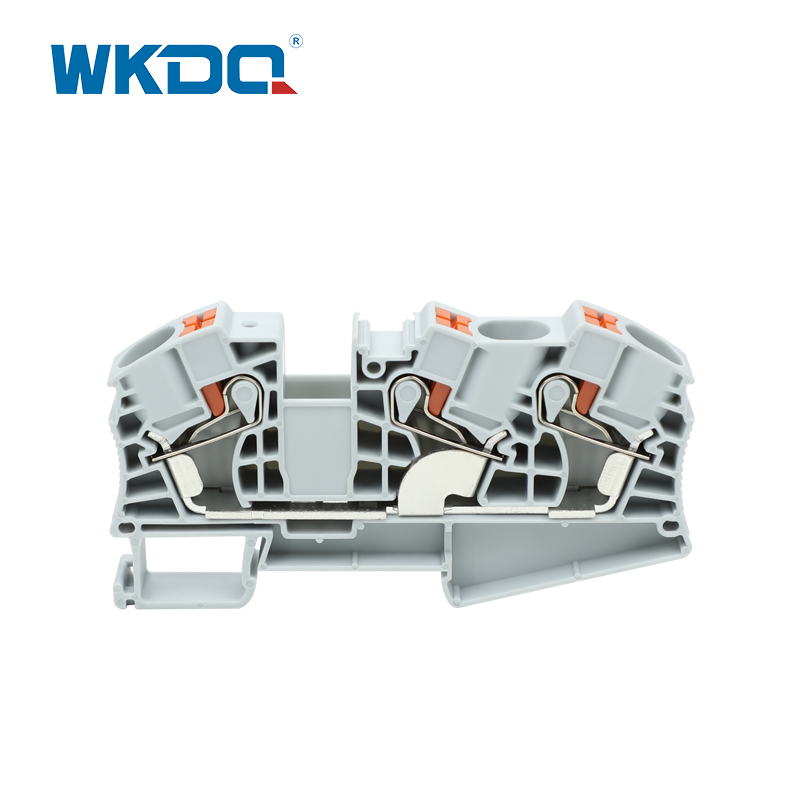What Is a Push-In Terminal Block and Why Is It So Popular in Electrical Wiring?
2025-01-07
When it comes to electrical systems, efficiency, safety, and ease of installation are paramount. One component that has gained popularity for its ability to meet all of these requirements is the push-in terminal block. Whether you're a seasoned electrician or a DIY enthusiast, understanding this simple yet innovative device can help you streamline your electrical projects.
But what exactly is a push-in terminal block, and why has it become such a popular choice in wiring applications? In this blog, we’ll explore the features, benefits, and common uses of push-in terminal blocks, and explain why they are an essential tool for modern electrical installations.
What Is a Push-In Terminal Block?
A push-in terminal block is an electrical connector used to join wires in a secure and reliable manner. Unlike traditional screw-in terminal blocks, which require the user to tighten screws to hold the wire in place, push-in terminal blocks use a spring mechanism to securely clamp the wire into place when it is simply pushed into the terminal.
The key advantage of this design is that it eliminates the need for tools such as screwdrivers, making the installation process much quicker and easier. The push-in mechanism offers a fast, tool-free connection, improving both the efficiency and safety of wiring work.
How Does a Push-In Terminal Block Work?
The mechanism of a push-in terminal block is relatively simple but effective. Here’s a step-by-step breakdown of how it works:
1. Prepare the Wire:
The wire is stripped of insulation, exposing a portion of the conductor. Typically, you’ll strip just enough to fit into the terminal block (usually around 10-12 mm).
2. Push the Wire Into the Terminal:
Once the wire is prepared, you simply push it into the terminal block. The terminal block features a spring-loaded clamp that holds the wire firmly in place.
3. Secure the Connection:
Once the wire is inserted, the spring inside the terminal block automatically grips the conductor, providing a secure connection without the need for any additional fastening. The spring mechanism ensures that the wire is held tightly, preventing it from slipping out.
4. Completion of the Circuit:
With the wire secured in place, the electrical circuit is now complete, and the connection is ready for use.
Why Are Push-In Terminal Blocks So Popular?
Push-in terminal blocks have gained significant traction in various industries due to the many advantages they offer over traditional screw terminals. Let’s take a closer look at why they are so widely used:
1. Tool-Free Installation:
One of the most significant benefits of push-in terminal blocks is that they require no tools to install. This makes wiring faster and more convenient, especially in environments where time and labor efficiency are crucial. Electrical professionals and DIY enthusiasts alike appreciate the simplicity of the push-in design.
2. Faster Wiring:
The quick and easy push-in mechanism saves a considerable amount of time compared to traditional screw terminals, where every connection requires a screwdriver to tighten or loosen the screws. This is especially advantageous in large-scale electrical installations or when working in tight spaces where using a screwdriver can be cumbersome.
3. Reliable and Secure Connections:
The spring-loaded clamp inside the terminal block provides a strong, vibration-resistant connection that minimizes the risk of loose or intermittent connections. This makes push-in terminal blocks ideal for high-vibration environments, such as machinery and automotive applications.
4. Consistency and Safety:
Push-in terminals are designed to make consistent, repeatable connections. With screw terminals, there is a risk of over-tightening or under-tightening, which can lead to poor connections or even short circuits. Push-in terminal blocks eliminate this risk, providing a secure and safe connection every time.
5. Compact Design:
Push-in terminal blocks typically have a compact design, which is advantageous in applications where space is limited. They are ideal for use in control panels, electrical enclosures, and other areas where saving space is a priority.
6. Wide Compatibility:
Push-in terminal blocks are compatible with a wide range of wire sizes, making them versatile for various electrical applications. They can handle both solid and stranded wires, offering flexibility when working with different types of electrical wiring.
7. Reduced Risk of Over-Tightening:
With traditional screw terminals, there is always a risk of over-tightening, which could damage the wire or terminal. Since push-in terminal blocks rely on a spring mechanism, there is no need to worry about over-tightening or damaging the components.
Types of Push-In Terminal Blocks
Push-in terminal blocks come in several different variations to suit different wiring needs. Here are some common types:
1. Single-Level Terminal Blocks:
These are the most basic type, with a single connection point for each wire. They are often used in simpler applications where only one connection is needed.
2. Multi-Level Terminal Blocks:
These terminal blocks stack multiple levels of connections, allowing for more compact wiring. They are useful when space is tight, and multiple connections are needed in a single block.
3. Plug-in Terminal Blocks:
These terminal blocks allow for easy connection and disconnection, making them ideal for applications that require frequent changes or maintenance.
4. Spring-Cage Push-In Terminal Blocks:
This type uses a spring-cage mechanism to hold the wire in place, ensuring a secure and reliable connection. They are commonly used in industrial applications where durability and reliability are critical.
5. Feed-Through Terminal Blocks:
These blocks are used when you need to make connections that pass through the terminal, allowing the current to flow from one wire to another. They are useful for creating simple parallel connections.
Common Applications of Push-In Terminal Blocks
Push-in terminal blocks are used in a wide range of applications, thanks to their versatility and ease of use. Some common uses include:
1. Electrical Panels:
Push-in terminal blocks are often used in control panels, where multiple wires need to be connected to a single point. Their compact design allows for efficient and organized wiring in these applications.
2. Industrial Machinery:
In industrial machinery, where vibrations and environmental factors can affect wiring stability, push-in terminal blocks provide secure connections that resist loosening over time.
3. Automotive and Transportation:
The vibration-resistant properties of push-in terminal blocks make them ideal for automotive and transportation wiring applications, where reliability and durability are crucial.
4. Home Automation:
Push-in terminal blocks are widely used in home automation systems, where ease of installation and secure connections are essential.
5. HVAC Systems:
HVAC systems often require a lot of wiring connections, and push-in terminal blocks offer a quick and reliable way to connect control systems, sensors, and power lines.
How to Choose the Right Push-In Terminal Block?
When selecting a push-in terminal block for your project, there are several factors to consider:
1. Wire Size and Type: Make sure that the terminal block you choose is compatible with the wire gauge and type (solid or stranded) you’re using.
2. Current Rating: The terminal block must be rated for the amount of current that will flow through it. Be sure to check the specifications of the terminal block to ensure it is suitable for your application.
3. Mounting Type: Consider how the terminal block will be mounted. Push-in terminal blocks are available in various mounting styles, including DIN rail-mounted, panel-mounted, or free-standing.
4. Environmental Conditions: Consider whether the terminal block will be exposed to harsh conditions such as high temperatures, moisture, or chemicals. There are special versions of push-in terminal blocks designed for more demanding environments.
5. Number of Poles: If you need to connect multiple wires in one terminal block, look for multi-pole blocks that can handle several connections at once.
Conclusion: Why Push-In Terminal Blocks Are a Game Changer
Push-in terminal blocks have revolutionized the way electrical connections are made, offering an easy, safe, and efficient way to wire electrical systems. Their tool-free installation, secure connections, and versatility make them an ideal choice for a wide range of applications, from industrial machinery to home automation. Whether you're working on a small DIY project or a large-scale electrical installation, push-in terminal blocks are a reliable and cost-effective solution to ensure your connections are fast, secure, and built to last.
As electrical systems continue to evolve, the push-in terminal block’s simplicity and efficiency will only become more valuable, helping to streamline wiring processes and improve overall electrical safety.



